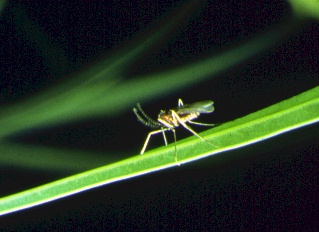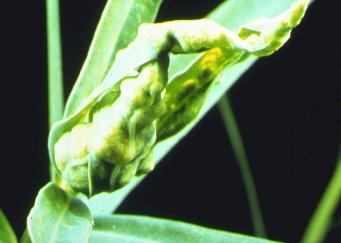-
Spurgia esulae
Leafy spurge tip gall midge
(Diptera: Cecidomiidae)
Insect Links. Photos: Eggs Galls Larvae Adults




Life Cycle:
Egg: Newly laid, egg is approximately .35mm (.01in) in length.
Lighter in color when it is young and becomes more dark, and chorion
(egg
cover) is soft and smooth when it is older. (4)
Larva: There are 3 stages that are generally concentrated in
gall. (4,3)
Pupal: Most generations of pupation occur in the gall, except
for the over wintering generations which pupate and pass the winter
burrowed
in the soil. (4,2)
Adult: Adults come out of the soil during early April. This
species of fly is very delicate, and adult stage is very short lived, a
matter of hours! Mating occurs in calm and cool periods of
twilight
and dusk. They do not move a whole lot during daylight when it is hot,
and the only time they will move during the day is to shaded areas.
(3,2)
Over Wintering: The lava burrows and spends the winter in the
soil as a pupa. (4)
Host Impact: Every
generation will attack growing tips
of leafy spurge plants causing a gall at the top of
the stem that deforms the leaves. This will destroy the shoot's ability
to make a flower thus destroying it's ability to produce seeds.
Eventually
the upper part of the plant will die. Then the plant will
grow
new stems which will be attacked by the future generations of Spurgia
esulae. (2-4)
Favorable and Unfavorable Release Habitats: They favor slopes facing south that are in cooler climates which have dense spurge. The insect survives well between wind breaks and do not live at all near rivers or other bodies of water. They need areas where the wind is blocked so they can rest and mate. (4)
How and Where to Collect, Transport, and Release: Adults can be collected with common sweep nets on hill sides and slopes facing south. They can also be found down wind from large shrubs or trees in open fields. Release in such areas also, but not near water bodies. However they are very delicate and short lived, so it is better to collect the infected galls. Keep them moist and green (as you would a plant cutting) and rapidly transport. (1,3)